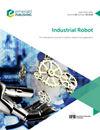工业机器人振动抑制的学习轨迹规划
IF 2.5
4区 计算机科学
Q3 ENGINEERING, INDUSTRIAL
Industrial Robot-The International Journal of Robotics Research and Application
Pub Date : 2023-05-10
DOI:10.1108/ir-02-2023-0013
引用次数: 0
摘要
目的提出一种用于抑制工业机器人残余振动的学习指数型跳振轨迹规划方法。基于有限脉冲响应滤波技术,一个适当幅度的阶跃信号首先通过两个线性滤波器,然后进行指数滤波器整形,得到指数跳振轨迹并抵消振荡模态。采用梯度下降原理设计的迭代学习策略在线调整指数滤波器的参数,达到最大的抑振效果。通过搭建SCARA机器人实验平台,进行了一系列对比实验。结果表明,与零振动整形器和零振动及导数整形器相比,该方法能有效抑制残余振动。采用的迭代学习策略思想简单,降低了控制器的计算能力。一种便宜的加速度传感器是可用的,因为它只需要测量振动能量来反馈。因此,该方法可应用于生产实践。本文章由计算机程序翻译,如有差异,请以英文原文为准。
A learning trajectory planning for vibration suppression of industrial robot
Purpose
This paper aims to propose a learning exponential jerk trajectory planning to suppress the residual vibrations of industrial robots.
Design/methodology/approach
Based on finite impulse response filter technology, a step signal with a proper amplitude first passes through two linear filters and then performs exponential filter shaping to obtain an exponential jerk trajectory and cancel oscillation modal. An iterative learning strategy designed by gradient descent principle is used to adjust the parameters of exponential filter online and achieve the maximum vibration suppression effect.
Findings
By building a SCARA robot experiment platform, a series of contrast experiments are conducted. The results show that the proposed method can effectively suppress residual vibration compared to zero vibration shaper and zero vibration and derivative shaper.
Originality/value
The idea of the adopted iterative leaning strategy is simple and reduces the computing power of the controller. A cheap acceleration sensor is available because it just needs to measure vibration energy to feedback. Therefore, the proposed method can be applied to production practice.
求助全文
通过发布文献求助,成功后即可免费获取论文全文。
去求助
来源期刊
CiteScore
4.50
自引率
16.70%
发文量
86
审稿时长
5.7 months
期刊介绍:
Industrial Robot publishes peer reviewed research articles, technology reviews and specially commissioned case studies. Each issue includes high quality content covering all aspects of robotic technology, and reflecting the most interesting and strategically important research and development activities from around the world.
The journal’s policy of not publishing work that has only been tested in simulation means that only the very best and most practical research articles are included. This ensures that the material that is published has real relevance and value for commercial manufacturing and research organizations. Industrial Robot''s coverage includes, but is not restricted to:
Automatic assembly
Flexible manufacturing
Programming optimisation
Simulation and offline programming
Service robots
Autonomous robots
Swarm intelligence
Humanoid robots
Prosthetics and exoskeletons
Machine intelligence
Military robots
Underwater and aerial robots
Cooperative robots
Flexible grippers and tactile sensing
Robot vision
Teleoperation
Mobile robots
Search and rescue robots
Robot welding
Collision avoidance
Robotic machining
Surgical robots
Call for Papers 2020
AI for Autonomous Unmanned Systems
Agricultural Robot
Brain-Computer Interfaces for Human-Robot Interaction
Cooperative Robots
Robots for Environmental Monitoring
Rehabilitation Robots
Wearable Robotics/Exoskeletons.

 求助内容:
求助内容: 应助结果提醒方式:
应助结果提醒方式:


